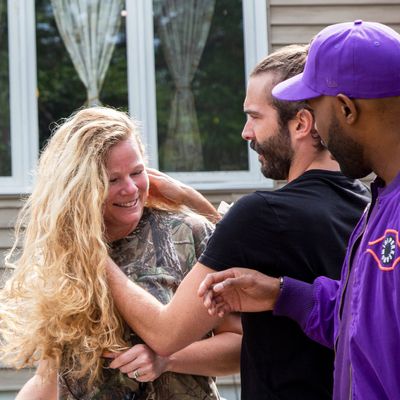
Reality TV, particularly of the feel-good, self-improvement variety, tends to follow a formula. That’s one of the reasons why it provides such comfort. While there are some variations from episode to episode, you more or less know how things are going to play out. It’s predictable, and that’s reassuring.
The trick is to be predictable without being too predictable. In its third season, Netflix’s Queer Eye is dancing — in an interstitial vignette in which all the members of the new Fab Five seem to be having the time of their lives, obviously — very delicately on that line. Don’t get me wrong: Tan, Karamo, Jonathan, Bobby, and Antoni are still charming and it’s still entertaining to watch them swoop into a new subject’s life and transform him/her/them from perfectly-fine-caterpillar into even-more-fine-butterfly. But three seasons in, Queer Eye has to contend with the fact that its template and rhythms have become very familiar.
The third season shifts the makeover setting from Atlanta and its environs to Kansas City, Missouri, practically the dead center of the United States. In the first four episodes of the season’s eight, the only ones made available to critics in advance, the quintet once again provides assistance to individuals who reside on a different end of the cultural spectrum from their own. Specifically: Jody, a correctional facility security guard and avid hunter; Joey, a summer camp program director whose approach to grooming is so dialed-down that he doesn’t shower very often; Deborah “Little” Jones and Mary “Shorty” Jones, sisters who run an old-school Kansas City barbecue joint; and Robert, a psych-ward nurse preparing to marry his long-term partner while struggling with a profound lack of self-confidence. In every episode, naturally, each of them finds common ground with the Fab Five, proving that, as Antoni puts it at one point, “People are people are people.”
If that statement sounds a little too kumbaya, or perhaps too Depeche Mode-ish, it’s also reflective of a gentler sensibility in these episodes of Queer Eye. The political and social overtones of the first two seasons — which often paired the Queer Eye gang with conservative types who had little experience around gay men, or, alternatively, gay and trans people buoyed by the quintet’s encouragement — are largely absent in season three. The closest this season gets to a political moment is when Tan and Jody, the woman who hunts in her spare time, have a conversation about gun control and realize they agree with each other. It’s refreshing in its way, but doesn’t feel as honest as the touchier conversations that previously unfolded between the Queer Eye guys and the not-quite-as-progressive individuals they were attempting to help.
“The original show was fighting for tolerance,” Tan France, Queer Eye’s resident fashion expert, said in the very first episode of season one. “Our show is fighting for acceptance.” But in the third season, fighting for acceptance barely seems necessary. All of the soon-to-be-made-over folks seem perfectly comfortable bonding with and trusting these men. Which is a good thing. But it also takes the conflict and some of the emotional charge out of watching it happen.
At this point, Jonathan Van Ness and co. are well aware that they’ve become pop-culture phenomena, and that awareness comes across at certain points. Antoni Porowski, the food guru who most recently became the poster child for third wheel-ism, knows he has a reputation as “the cute one” and flirts with the camera accordingly. (He tags along — again, third wheel — on a trip to Orangetheory Fitness, and Bobby just straight-up acknowledges that Antoni is there because he looks good lifting weights.)
Tan knows he’s famous for telling literally everyone on planet Earth to do a French tuck, and he calls himself out for it. (But he also doesn’t stop doing it.) Karamo Brown, surely the holder of the Guinness World Record for owning the most bomber jackets, still looks into camera and gives earnest advice like, “Beauty is believing in yourself,” which Tan follows with an even more earnest declaration that, “Beauty is confidence.” I never rolled my eyes during the first two seasons of Queer Eye, but there are moments this season that make my eyeballs itchy to do a little backflip.
In fairness, there are moments when those same eyeballs do get wet with tears, especially in the third episode that focuses on the Jones sisters. These women sweat it out in a very tight, hot kitchen to make food for a living, because that’s what they’ve always done. They’re so busy serving the meat and slaw, they barely have time to think about pampering themselves or making their lives easier, so it’s especially sweet when the Queer Eye guys insist on giving them the Cinderella treatment. The absolute highlight is watching Shorty, who has been embarrassed for years by a missing tooth, finally get that smile fixed. The first time she sees herself in the mirror and can let that grin open wide without self-consciousness … well, good luck not getting verklempt when you watch that part, that’s all I’m saying.
Moments like that still make Queer Eye a pleasure, the kind of television that fits the bill perfectly if you want to see people be kind to one another while simultaneously offering excellent tips about proper moisturizing techniques. If the last four episodes of season three are anything like the first, this season will be closer to pure, undistilled comfort food and less interested exploring the divides that run so deep in this country. Personally, I miss that exploration, because I think it makes Queer Eye meaningful without sacrificing its playfulness. But I will likely be alone in missing the more political episodes. Plenty of people will be grateful to Queer Eye for being less issue-driven and more purely escapist. Make Queer Eye Makeover-Focused Again? Yeah, I can imagine some viewers approving that message.


